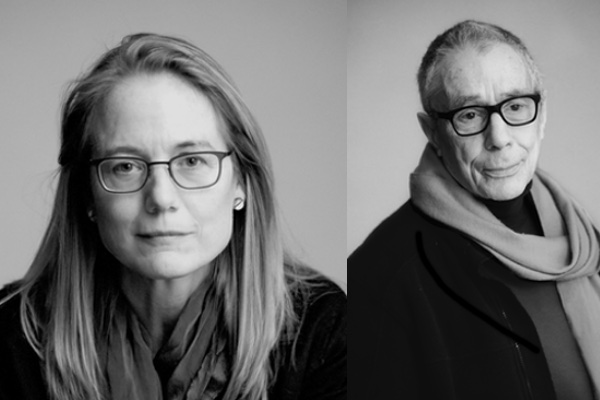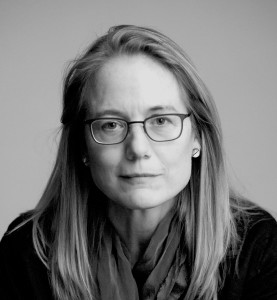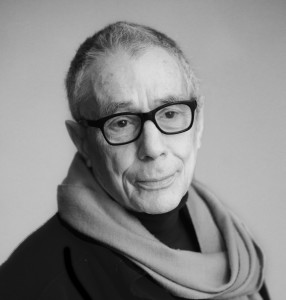(left to right: Leila Philip and Garth Evans
In 2012, writer Leila Philip and artist Garth Evans set out to challenge themselves. Philip, an award-winning prose writer, wrote poems. Evans, an internationally renowned sculptor, made watercolors. Philip’s realist poems—about nature, beauty, love, and loss, set amongst Evans’ abstract, deeply hued, layered watercolors–create a book which is more than just a gorgeous read and a visual feast. What emerges in this book is a stunning and original collaboration, which, as Worcester Art Museum Director, Matthias Waschek, points out in his introduction, extends how we think about the relationship between painting and poetry. And as praised by David St. John, author of Study the World’s Body, “The paintings and poems of Water Rising celebrate our insistence that, in the face of much darkness, we will continue to live along the shores of light and great beauty.” See excerpts from the book in this month’s Woven Tale Press.
Interview with Leila Philip on her collaboration with Garth Evans for Water Rising:
Water Rising is a beautiful collaboration between a poet and an artist– how did you and Garth originally connect and conceive of the idea for this collaboration?
One day, about three years ago, Garth came upstairs from his studio with the idea that we collaborate on something. He did not have an idea about what that might be, but I liked the suggestion. We talked at length about what this might mean and how such a project could take shape. Garth had done a collaborative art project years earlier with the painter Barry Kahn, so he had some experience, but this was going to be a collaborative project between a writer and a visual artist, which is quite different. That was part of the appeal, to see what we could create across such different artistic genres.
We began by looking at the ways in which other creative people had worked collaboratively. We looked at the experimental art projects of artists like Merce Cunningham and John Cage, Walker Evans and James Agee. That was really interesting. Then we came up with our own working rules. One was that we would both work in genres outside of our usual practice. I wrote prose but for this project I would work in poetry, and Garth is a sculptor but would make works on paper, watercolors. We wanted a structure that forced us to really stretch ourselves. We also agreed that we would work for a year, making works consistently, each month, but that we would not share these works until the year was over.
So our collaboration began with a necessary phase of us working independently in the same location. This was important to us because Garth did not want to “illustrate” my poems with his images, and I was trying to avoid writing ekphrastic poetry.
Over the course of a year, you evidently both produced more work than would be included in the book. How did you go about your final selection?
I had a series of eleven poems that I was particularly excited about because, when I read my work over, they stood out as a kind of poetry cycle. I suggested to Garth that we select a similar number of watercolors. He had produced quite a lot of beautiful watercolors and together we selected twelve that we both had strong responses to.
At this point, I gave Garth the eleven poems. I also gave them to a friend of ours who is a painter and had become intrigued by our project. Soon after, we laid the poems out on the floor of Garth’s studio alongside the watercolors and the three of us walked through the poems and the watercolors, looking. It was amazingly easy to sort them and to see which poems belonged with which watercolors. We were all in total agreement about the proper association of watercolor/poem, which was remarkable and was part of what led us to decide that we wanted to publish them together as a book.
Water Rising is unique in that it has a musical component. Can you elaborate on this?
I had a poster up announcing a reading I was scheduled to give that included the first line of the title poem, and the composer Shirish Korde saw the poem and contacted me, wanting to know more. The opening line “Beavers are the shiva of the animal world,” had intrigued him. This led to him giving me some CDs of his, and he suggested that he would like to think about setting that poem to music. When I listened to Shirish’s music I was amazed by it and immediately felt there was a strong connection to the poems. Garth had a similar reaction. When he heard Shirish’s music–I think it was the piece “Anusvara“–he said he wished that, if his watercolors could made a noise, that was what they would sound like!
Shirish then came to do a studio visit and spend time with the watercolors and read all eleven poems. He then suggested that he set two of the poems “Here,” and “Water Rising” to some of his music, and we ended up performing that in two locations last year. We have been invited by a great performance venue in New York City, Wave Hill in Riverdale, to perform this musical collaboration in New York City next fall. Shirish now plans to set more of the poems to music as a song cycle and to bring more musicians in, so it is very exciting.
As Garth is primarily a sculptor, how did he arrive at watercolor as the medium for this book?
Garth had made a lot of watercolors back in the 80’s. They had sold well but he stopped making them because he found he was unable to combine the activity with anything else–it was completely absorbing him. As he describes it, making watercolors was like gambling and it was strangely addicting. When we were thinking about how to collaborate and agreed to each do something outside our current practice, Garth said he thought he would like to have a go at making watercolors again.
And you are the author of three nonfiction books, and you write a lot of essays. How did you transition from nonfiction, especially memoir, to the writing of poetry?
Yes, that is a good question. Poetry is so very different from prose. The whole way you have to approach the words on the page takes a different sensibility. I wasn’t coming in completely cold because a few years earlier, when I had a Guggenheim Fellowship, I spent the final months of the fellowship time working on poetry because I had finished the project I had set out to write ahead of schedule. So I had a great time reading poetry, studying how my favorite poems worked, and learning how to write my way back into a feel for the lyric. I say back because as an undergraduate at Princeton I had studied poetics and Japanese poetry and wrote a lot of poetry and worked on translating medieval Japanese poems to English. But it was curious, for many years I lost the way to write poetry completely, I just could not get to that place where a poem comes from. So I was excited and also nervous about undertaking the collaboration because I wasn’t sure if I’d end up with anything. That also was, by the way, important to each of us, to do something that really felt like we were taking creative risks and challenging ourselves. To feel we might work for a year and discover that nothing really creatively had “happened,” but to go forward anyway and engage the process without thinking too much about outcome.
Art critic Carter Ratcliff, in his review of Water Rising, writes of your collaboration with Garth: “Each is as much an abstractionist or a realist as the other.” From your own perspective how do these opposing forces come into play in Water Rising?
I think Carter Ratcliffe is on to something here. While my poems begin with some sort of observation of the natural world and seem to describe things in a straightforward realistic way, in the end they are about something more abstract, about what we value, about what is important. They aren’t really about the natural world in a literal way at all.
And Garth’s watercolors do not represent anything specific, anything you can name, yet when you look at them you grasp that they are in some strange way “real”. What I mean is that the watercolors, when you give yourself to them, end up offering them themselves up as “facts.” This paradox is at the center of the collaboration and the book, because, when you let the poems and the watercolors interact they can, I think, lead you to a new way of “seeing” not possible without that interaction.
Can you tell us about how Water Rising came to be connected to your mission of environmental stewardship?
The environmental mission grew from the project. It was not something we set out to do, but in hindsight it was there from the beginning. I had been reading Emerson’s wonderful essay “Nature” at the onset of the project, and was thinking about his call to “see” the ordinary landscapes around us as a means of interaction and change. So for me, an interest in an encounter with the natural world as initial subject matter was there from the beginning.
On another level, once we associated the poems with the individual images and decided that the way to make the material available and to extend the collaboration was to create a book that contained both images and poems, we saw that a theme of being present to the “here and now” was a shared theme for both of us. We live in the same location in Woodstock, CT, and we live on a dirt road surrounded by woods. Once we recognized our shared theme of being present and in contact with the natural world around us as we made the works in the book, we thought we’d like to find a way to use the book to help preserve that world. We wake up at night as worried as the next person about the environmental degradation going on around us. Our planet is in trouble. We wanted to use the book to do at least something, to help generate conversation about and even funds, to help support efforts to preserve it. And of course there is a long tradition of American art and literature leading to environmental activism.
How did you find a publisher for Water Rising?
We did not have difficulty in finding a publisher, several presses responded to the work with enthusiasm, but it was difficult to find a publisher that shared our vision for the book and was willing to produce a book of the quality we wanted. New Rivers Press stood out because they have this wonderful, long and important literary heritage – they are one of the oldest nonprofit literary presses in the country – but they were willing to work with us to find a way to reproduce the art at a high quality. In the end they were willing to try out a unique partnership with Marquand Books of Seattle and let them do the actual art reproduction and printing.
How involved were you in the actual production and design of the book?
Very involved and that was important because from the beginning we saw the book as an art object of its own and an extension of the collaboration. So we worked extensively on book design and production. Marquand books assigned a wonderful designer, Ryan Polich, to work with us and there was ongoing back and forth. We’d send him our ideas and he’d make them concrete with a mock-up which included ideas of his own which we would review and send back with our responses.
This kind of back and forth went on at every stage of production. Ryan was able to incorporate our suggestions and allowed us to be very “hands on” in regard to every little detail, without ever growing impatient with us. He really got into every little detail along with us! This was wonderful and more than we had hoped for. It was also great that our editor at New Rivers, Al Davis, and managing editor, Suzanne Kelley, allowed us to have creative control once the content was approved by them.
Anything else that you would like to add?
Well, we hope people will buy the book. We like to think of people dipping into it every now and again and finding that, over time, they find that the watercolors and their associated poems have become one single entity. Buying the book helps us support environmental stewardship. Because we raised funds to cover the art reproduction costs by selling some of the artwork in the book, we are able donate 100% of net proceeds from book sales to groups working on environmental stewardship. This past month we wrote checks to CT. Aububon and a local land trust here from book sales in November. Small organizations can really benefit from even modest funds. We hope that knowing that by purchasing the book they are helping environmental stewardship, people can enjoy it even more.
We can only do this, however, if it is purchased on our website. www.water-rising.com. Amazon and at Small Press Distribution have it for sale, but they take a large cut, so we created a way for people to buy it directly.
Leila Philip is the author of three books, including The Road Through Miyama (Random House 1989, Vintage 1991), for which she received the 1990/PEN Martha Albrand Special Citation for nonfiction, and the award-winning memoir A Family Place: A Hudson Valley Farm, Three Centuries, Five Wars, One Family (Viking 2001, Vintage 2002, SUNY 2009). Philip has received numerous awards for her writing, including from the John Simon Guggenheim Foundation, The National Endowment for the Arts, and the National Endowment for the Humanities.
Garth Evans is a British sculptor with an international reputation whose practice is central to the narrative of British sculpture. His work is included in major public collections, including: The Metropolitan Museum, Museum of Modern Art, NY, the Brooklyn Museum, Joseph H. Hirshhorn Museum and Sculpture Garden, Tate Gallery, Victoria and Albert Museum, the British Museum, and the Museum of Contemporary Art, Sydney, Australia, among many others.



